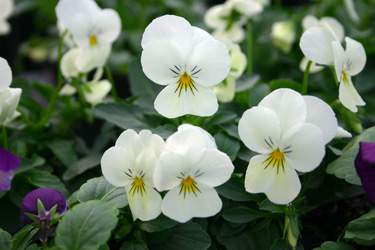Pansy perfection
They may have sprung from Victorian times, but there is nothing prudish or prissy about today’s pansies.
Pansies (Viola x wittrockiana) and their smaller viola cousins, have kept up with the times as favourites among flowers that are easy to grow and deliver premium colour on tougher and tougher plants.
Heat tolerant
Most importantly, pansies and violas are getting more and more tolerant of weather extremes, especially heat. Older forms didn’t stand up to summer heat, but well before global warming was on our radar, breeders were working to produce pansies that would thumb their nose at warmer weather. And they keep on getting better. Todays pansies perform longer into summer and earlier in autumn than ever.
Modest beginnings
Like most of our most colourful garden annuals, pansies as we know them were never flowers of nature. It was only after their more demure ancestors caught the eye of mankind that they came into being. Todays pansies result from two hundred years of selection and cross breeding.
The ascent of the modern pansy began in the 1800s with the humble heartsease (Viola tricolour) and a few of her wild viola cousins, which were propagated in the gardens of certain English aristocrats and their gardeners. By 1840 the progress was already impressive.
In her 1840 book “The Ladies Flower Garden of Ornamental Annuals” Mrs Jane Louden wrote, ‘The heartsease, notwithstanding its curious internal construction, is so small, and apparently so unpretending, that it is scarcely possible to imagine that the large and magnificent flowers now called Heartseases by florists, can have sprung from it. The variety of forms and colours which appear in the plants raised from seed is indeed so great, that few floricultural pursuits can be more interesting, than to sow a bed of pansies’.
Spoilt for choice
Today we can still feel the thrill of growing pansies or violas from seed. We also have the great advantage of being able to buy our plants in flower and choose exactly the colours we want from a seemingly endless range of faces. Pansies offer us a paintbox of living colour so we can colour coordinate to our hearts content, filling gaps in garden borders, or creating colour spots in pots.
Potted bliss
Arguably the best way to grow pansies is in containers. They’re great as quick fix colour and they make excellent companions for bulbs such as tulips and daffodils, flowering before the bulb flowers appear and continuing after the bulbs have died down. Choose already flowering plants to enjoy instant impact on plants that will keep growing and flowering right through the year. As long as they receive plenty of moisture, pansies and violas love the well drained potting mix and being kept away from foraging slugs and snails (even so, it pays to guard against these pests, which get active in cool rainy weather).
Pansy perfection
- Plant in well drained soil in sun or part shade.
- Always plant with a small teaspoon of dried blood.
- Protect from snails.
- Remove spent flowers (or pick a pansy bouquet) to encourage more flowers.
- Feed with slow release or liquid fertiliser.
- If pansies get tatty over winter, trim them back and feed them, A fresh crop of flowers will soon appear.
18-Feb-2016

Pansy

Violas

Pansy bowl

Self sown pansies


